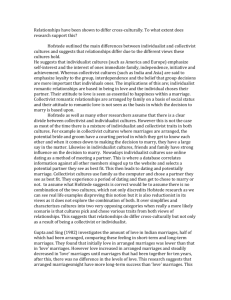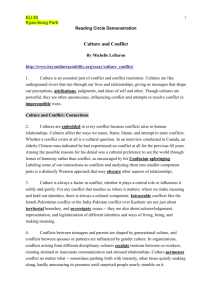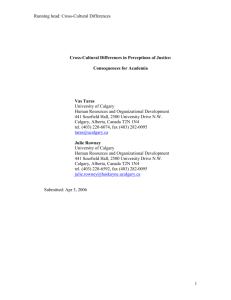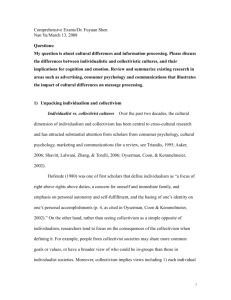Cross-Cultural Communications
advertisement
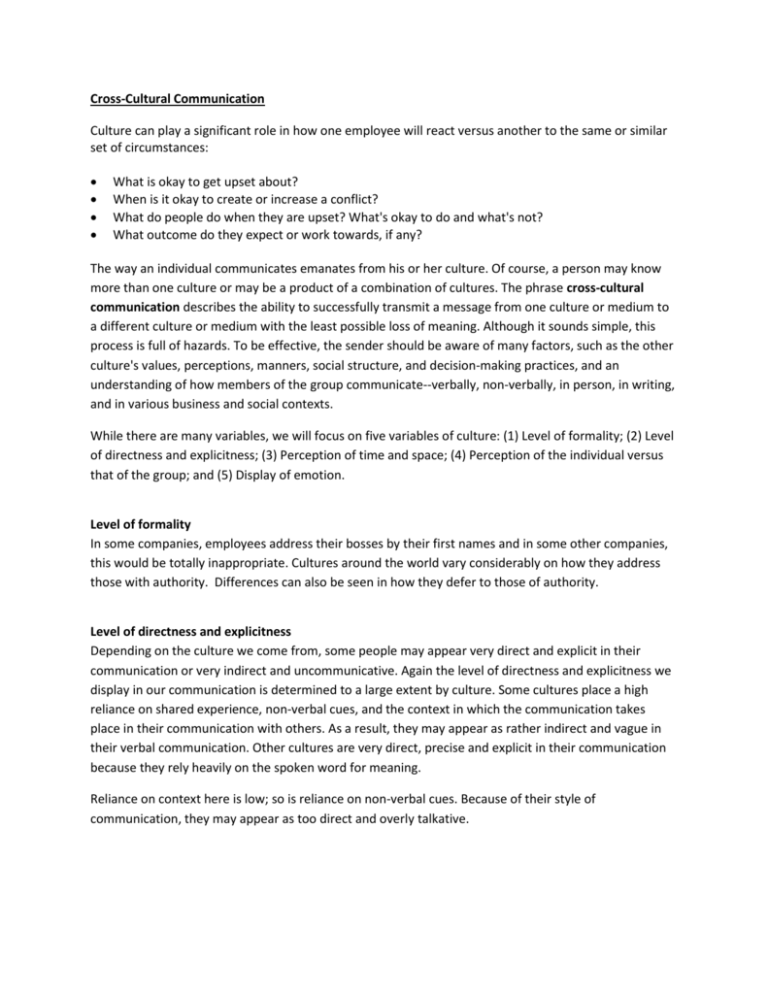
Cross-Cultural Communication Culture can play a significant role in how one employee will react versus another to the same or similar set of circumstances: What is okay to get upset about? When is it okay to create or increase a conflict? What do people do when they are upset? What's okay to do and what's not? What outcome do they expect or work towards, if any? The way an individual communicates emanates from his or her culture. Of course, a person may know more than one culture or may be a product of a combination of cultures. The phrase cross-cultural communication describes the ability to successfully transmit a message from one culture or medium to a different culture or medium with the least possible loss of meaning. Although it sounds simple, this process is full of hazards. To be effective, the sender should be aware of many factors, such as the other culture's values, perceptions, manners, social structure, and decision-making practices, and an understanding of how members of the group communicate--verbally, non-verbally, in person, in writing, and in various business and social contexts. While there are many variables, we will focus on five variables of culture: (1) Level of formality; (2) Level of directness and explicitness; (3) Perception of time and space; (4) Perception of the individual versus that of the group; and (5) Display of emotion. Level of formality In some companies, employees address their bosses by their first names and in some other companies, this would be totally inappropriate. Cultures around the world vary considerably on how they address those with authority. Differences can also be seen in how they defer to those of authority. Level of directness and explicitness Depending on the culture we come from, some people may appear very direct and explicit in their communication or very indirect and uncommunicative. Again the level of directness and explicitness we display in our communication is determined to a large extent by culture. Some cultures place a high reliance on shared experience, non-verbal cues, and the context in which the communication takes place in their communication with others. As a result, they may appear as rather indirect and vague in their verbal communication. Other cultures are very direct, precise and explicit in their communication because they rely heavily on the spoken word for meaning. Reliance on context here is low; so is reliance on non-verbal cues. Because of their style of communication, they may appear as too direct and overly talkative. Perception of time & space Cultures also differ in their perception of time and space. Space shows as proximity to standing to each other; some prefer being close when they speak to others while other cultures are more comfortable with a lot of difference. Time becomes apparent between cultures with respect to sense of urgency in completing tasks/being on time for meetings/priorities/management of time. Perception of the individual versus that of the group The “individualist” culture is defined as one in which the ties between individuals are loose: everyone is expected to look after himself or herself and his or her immediate family/community/team. In a “collectivist” culture, people are integrated into strong, cohesive groups, which throughout their lifetime continue to protect them in exchange for unquestioning loyalty. In an individualist culture, independence is highly valued. In a collectivist culture, an individual is regarded as a part of the group and a high degree of interdependence among individuals prevails in the same group. In an individualist culture, a single person can earn credit or blame for the success or failure of a project. In a collectivist culture, however, credit or blame goes to the group. In such a culture, individuals do not seek recognition and are uncomfortable when it is given. Display of emotion Cultures also differ in their expression of emotion. Members of some cultures tend to be more expressive with their emotions and show their feelings plainly by laughing, shouting and scowling. However, in some cultures, members tend to be more reserved and do not show their feelings openly but rather keep them carefully controlled and subdued. For example, they might cover up their mouths when laughing or look down when irritated. People from the more expressive culture may view people from the reserved culture as cold or unfeeling or standoffish. On the other hand, people from the reserved culture may consider their more expressive colleagues as immature and obnoxious. The following can enhance cross-cultural communication: Identifying own behaviors and responses Identifying our stereotypes Recognizing other people’s anxieties, pressures and determination to preserve their culture Admitting our fears of unknown and trying to learn as much as possible of other’s cultures Listening carefully and empathetically, without judgement Expressing ourselves honestly, clearly and compassionately Conclusions The purpose of cross-cultural communications is to be cognizant of what could be influencing our communications with each. It is not to be used as another tool in order to stereotype another person. It is dangerous to assume that people from countries similar to our own will be similar to us, just as those from countries and cultures different to ours will be different. While culture does play a role in making up someone’s personality and behaviours, so do many, many other variables such as education, family, gender, age, socio-economic-political-religious background, individual evolution and preferences, etc.







